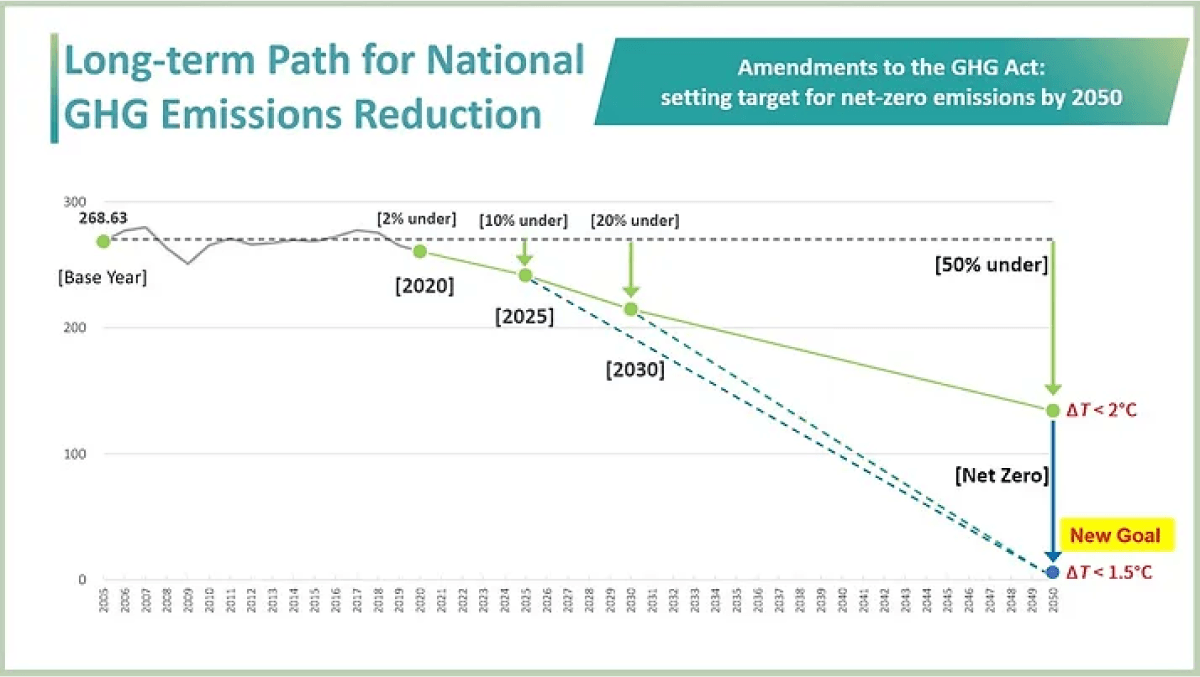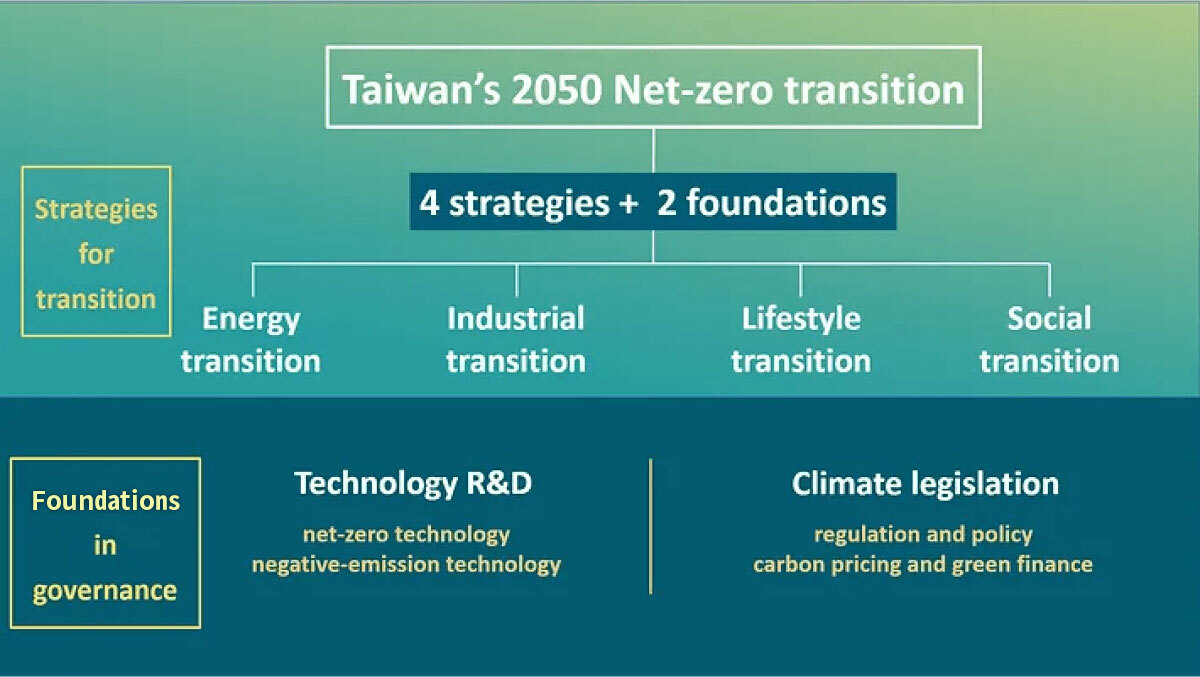
Net Zero Roadmap
President Announced Taiwan 2050 Net-Zero Goal
The President Announces the Revision of "Greenhouse Gas Management Act" into "Climate Change Response Act" and the Amendment of Articles
Cross-departmental Collaboration Mechanism of Taiwan 2050 Net-Zero Pathway Was Established
In March 2022, Taiwan officially announced "Taiwan's Pathway to Net-Zero Emissions in 2050," which provides a trajectory and action path to 2050, in order to promote technology, research and innovation in key areas, guide the green transition of industries, drive economic growth, and promote green financing and increased investment at various key milestones to ensure a fair and smooth transition period.

Taiwan's pathway is based on the 4 major transition strategies of "energy transition," "industrial transition," "lifestyle transition" and "social transition", as well as the 2 governance foundations of "technology R&D" and "climate legislation," and is supplemented by "12 key strategies." It aims to develop action plans for key areas of expected growth with regard to energy, industrial, and life transitions to implement net-zero transition goals.

Environmental sustainability and competitiveness is equally important to us. In order to accelerate economic growth, drive private investment, generate green employment, achieve energy autonomy and enhance social welfare, governments make competitive, sustainable, resilient, and secure governance foundations and transition strategies.
12 action plans for key areas were identified with regard to net-zero energy, industrial, and lifestyle transitions.
The development of renewable energies will be based mainly on wind power and photovoltaic power. The development of wind power will focus on large-scale, floating offshore wind turbines. The installed capacity of offshore wind power is expected to reach 13.1 GW by 2030 and 40-55 GW by 2050. As for photovoltaic power, expansion of installed capacity will be achieved through diverse land applications. The installed capacity of solar photovoltaic power is expected to reach 30 GW by 2030 and 40–80 GW by 2050.
With hydrogen energy as the main option to achieve net-zero emissions, it will be used as the raw material for zero-carbon processes in the industry, and carbon-free fuels for transportation and power generation. By using imported green hydrogen as the main source and combining it with domestic hydrogen production via renewable energy, hydrogen reception, transportation, and storage infrastructure, as well as hydrogen utilization systems will be gradually constructed.
To increase renewable energy options, the development of forward-looking energy will focus on base-load geothermal energy and ocean energy, promoting demo verification and block development, while boosting the development of green energy industries. In addition, the use of biomass energy will be increased. The source of materials will be stabilized through domestic resource recycling and imports. Moreover, advanced biomass energy technologies will be developed. It is expected that the installed capacity of forward-looking energy will reach 8–14 GW by 2050.
Promote distributed power grids and strengthen power grid resilience. Promote the digitization and operational flexibility of power grid to improve power grid adaptability, and use the IoT (Internet of Things) as well as information and communication technology to promote system integration. Increase the installation of energy storage systems, develop key technologies for energy storage and build incentives for energy storage business models.
Expand the application of well-developed technologies in manufacturing, homes, and business services, transportation, and cross-sectoral aspects as soon as possible to improve energy efficiency; accelerate market penetration rates for high-efficiency equipment through measures such as economic incentives, education and guidance, and mandatory regulations. Develop innovative energy technologies, and gradually introduce forward-looking technologies to comprehensively improve energy efficiency from the demand side, achieving the goal of net-zero emissions.
Use carbon capture, utilization, and storage technologies to remove carbon emissions from industries and energy facilities; give priority to the development of carbon capture and utilization technologies that can serve as the source for chemical raw materials and building materials; establish a carbon cycle value chain. Furthermore, develop local potential sites for carbon storage and implement a safety verification site program.
Develop the upstream and downstream industries related to electric vehicles, set the future market share target of motorcycles/motor-scooters, passenger cars, and buses based on technology maturity; integrate the technological R&D and construction of infrastructure for energy storage, charging stations, and building charging safety. As for the development of large electric buses and trucks for long-distance travel, introduction and promotion of such will depend on the availability of relevant technologies.
The action plans for this key area are improving source reduction, promoting green design and green consumption. Besides, strengthen the sustainable reutilization of resources of waste recycling. Link upstream, mid-stream, and downstream industry to form industry chains for resource recycling, invest in technology R&D and system innovation, and improve resource recycling efficiency. Create an era of sustainable resource recycling with zero waste, based on four aspects: Product design, resource regeneration, industry chains, and technological innovation.
Through the implementation of afforestation and management measures for such, reduce atmospheric carbon dioxide concentrations. Establish carbon-negative farming methods, as well as marine habitats and animal-and plant-conservation techniques to protect biodiversity, avoid soil loss, conserve forests, and restore carbon sink ecosystems to enhance carbon absorption.
Achieving net-zero emissions by 2050 will require lifestyle transitions for all people, and the promotion of "net-zero green living". In terms of food, clothing, housing, and transportation, and via public consensus through social communication, education, promotion, and behavioral changes, build low-carbon business models, creating the green living industry chain.
Use the power of financial markets to guide the economy toward net-zero emissions, improve financial sector and industry climate resilience, build a sound and sustainable financial ecosystem, promote listed companies' completion of greenhouse gas inventories and verification according to schedule, strengthen information disclosure, and continue to improve Taiwan's taxonomy regulations, serving as guidelines for enterprise transformation.
With the goal of "doing the utmost to leave no one behind" in carrying out just transition, strive to pursue a balance of policy goals, fairness of social distribution, and inclusiveness of interests in the process of the net-zero transition.
